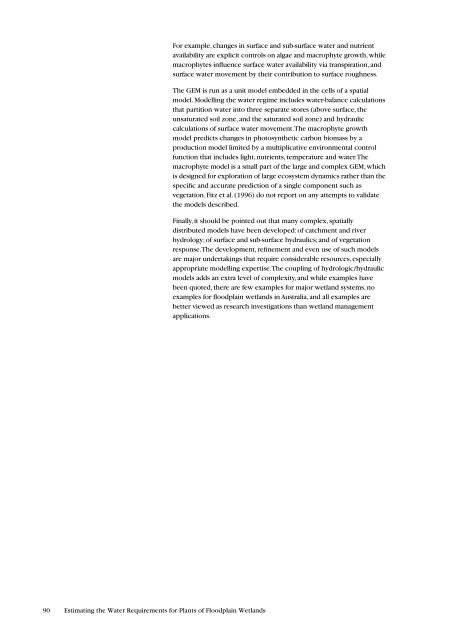Estimating the Water Requirements for Plants of Floodplain Wetlands
Estimating the Water Requirements for Plants of Floodplain Wetlands
Estimating the Water Requirements for Plants of Floodplain Wetlands
Create successful ePaper yourself
Turn your PDF publications into a flip-book with our unique Google optimized e-Paper software.
For example, changes in surface and sub-surface water and nutrientavailability are explicit controls on algae and macrophyte growth, whilemacrophytes influence surface water availability via transpiration, andsurface water movement by <strong>the</strong>ir contribution to surface roughness.The GEM is run as a unit model embedded in <strong>the</strong> cells <strong>of</strong> a spatialmodel. Modelling <strong>the</strong> water regime includes water-balance calculationsthat partition water into three separate stores (above surface, <strong>the</strong>unsaturated soil zone, and <strong>the</strong> saturated soil zone) and hydrauliccalculations <strong>of</strong> surface water movement. The macrophyte growthmodel predicts changes in photosyn<strong>the</strong>tic carbon biomass by aproduction model limited by a multiplicative environmental controlfunction that includes light, nutrients, temperature and water. Themacrophyte model is a small part <strong>of</strong> <strong>the</strong> large and complex GEM, whichis designed <strong>for</strong> exploration <strong>of</strong> large ecosystem dynamics ra<strong>the</strong>r than <strong>the</strong>specific and accurate prediction <strong>of</strong> a single component such asvegetation. Fitz et al. (1996) do not report on any attempts to validate<strong>the</strong> models described.Finally, it should be pointed out that many complex, spatiallydistributed models have been developed: <strong>of</strong> catchment and riverhydrology; <strong>of</strong> surface and sub-surface hydraulics; and <strong>of</strong> vegetationresponse. The development, refinement and even use <strong>of</strong> such modelsare major undertakings that require considerable resources, especiallyappropriate modelling expertise. The coupling <strong>of</strong> hydrologic/hydraulicmodels adds an extra level <strong>of</strong> complexity, and while examples havebeen quoted, <strong>the</strong>re are few examples <strong>for</strong> major wetland systems, noexamples <strong>for</strong> floodplain wetlands in Australia, and all examples arebetter viewed as research investigations than wetland managementapplications.90 <strong>Estimating</strong> <strong>the</strong> <strong>Water</strong> <strong>Requirements</strong> <strong>for</strong> <strong>Plants</strong> <strong>of</strong> <strong>Floodplain</strong> <strong>Wetlands</strong>
















